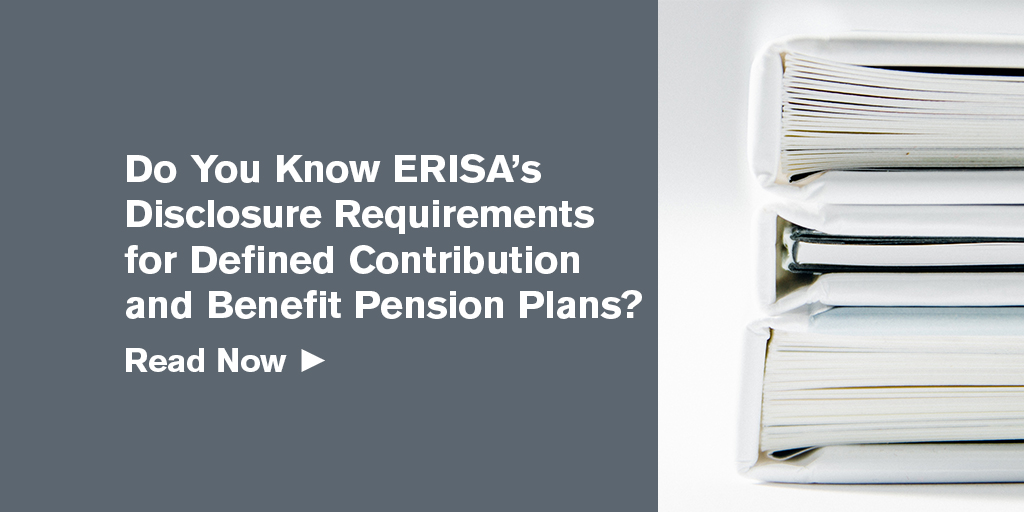Qualified retirement plan sponsors are subject to many disclosure requirements. Here’s a “top ten” (and thus incomplete) list of key required defined contribution plan disclosure documents from the Department of Labor (DOL), offered to reinforce a general understanding of those requirements. A note of caution: This list doesn’t include IRS disclosure requirements. Also, while disclosures are generally directed to plan participants, a plan beneficiary, in the case of a participant’s death, typically would also be covered by the disclosure rules.
The Top 10
- Summary plan description (SPD). You must provide this automatically to new participants within 90 days of their becoming covered by the plan. It’s the most basic and comprehensive document describing the plan and its operations. The SPD must be written in language that can be understood by the average participant, and be current as of no more than 120 days from the date the plan is established. You must then furnish an updated SPD to all covered participants every five years if there are changes, and every ten years if the SPD hasn’t changed.
- Summary of material modification (SMM). Plans must provide an SMM to plan participants no later than 210 days beyond the end of the plan year in which the plan was “materially” changed. In effect, this is an update to the SPD.
- Summary annual report (SAR). Participants must receive the SAR within nine months of the end of the plan year, or, if an extension to file the IRS Form 5500 is made, two months following the extended deadline. This report is a narrative description of the information on the Form 5500.
- Plan documents. Plan sponsors have to furnish the plan’s highly detailed governing legal documents on receipt of a request from a participant. You have 30 days from receipt of the request to do so. These include your trust agreement, Form 5500 and the documents listed above.
- Notification of benefits determination. This document explains the basis of an adverse determination decision. You must generally provide it within 30 days of that decision. It must reference specific plan document provisions that the decision was based on, and explain appeals procedures.
- Periodic benefit statement. You must provide a periodic benefit statement at least quarterly for participant-directed individual account plans and annually for all other individual account plans. Among other things, the statement must cover the participants’ account balances, their ability to change their investment selections and a statement that holding more than 20% of a portfolio “in the security of an entity (such as employer securities) may not be adequately diversified.”
- Participant plan investment options, investment fees and other expenses. Plans must furnish this disclosure to participants at least annually. It must describe general administrative and investment costs, as well as individual charges to participants for particular services such as plan loans. For each investment option, it must also include a chart showing fees and expenses, investment performance, and relevant investment benchmark data.
- Section 404(c) plan investment options. You must provide information about plan investment options both before a participant provides investment instructions and on request. This notice gives sponsors the legal protections from possible participant litigation involving the adequacy of investment options offered by the plan.
- Qualified default investment alternative (QDIA) notice. Participants must receive an initial QDIA notice within at least 30 days of plan eligibility or 30 days of when any QDIA investment is made on behalf of participants. It must describe the circumstances under which participant contributions will be directed to a QDIA, the investment objectives of the QDIA and what participants need to do if they don’t want their contributions invested in that vehicle.
- Automatic funding notice. This is essentially equivalent to the QDIA notice; participants must be informed if the plan will be defaulting participants into a deferral pattern.
Just the Beginning
As noted, this isn’t a complete list. But it should give you a head start when you sit down with your plan administrator for a more comprehensive education on ERISA’s disclosure requirements for defined contribution plans. Most of the above also apply to defined benefit pension plans, but those plans have many additional disclosure requirements. Failing to provide required disclosures may result in fines and penalties.
 Qualified retirement plan sponsors are subject to many disclosure requirements. Here’s a “top ten” (and thus incomplete) list of key required defined contribution plan disclosure documents from the Department of Labor (DOL), offered to reinforce a general understanding of those requirements. A note of caution: This list doesn’t include IRS disclosure requirements. Also, while disclosures are generally directed to plan participants, a plan beneficiary, in the case of a participant’s death, typically would also be covered by the disclosure rules.
Qualified retirement plan sponsors are subject to many disclosure requirements. Here’s a “top ten” (and thus incomplete) list of key required defined contribution plan disclosure documents from the Department of Labor (DOL), offered to reinforce a general understanding of those requirements. A note of caution: This list doesn’t include IRS disclosure requirements. Also, while disclosures are generally directed to plan participants, a plan beneficiary, in the case of a participant’s death, typically would also be covered by the disclosure rules.

